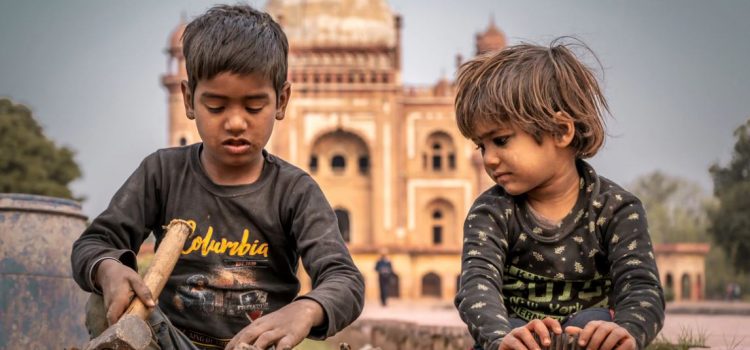

This article is an excerpt from the Shortform book guide to "Caste" by Isabel Wilkerson. Shortform has the world's best summaries and analyses of books you should be reading.
Like this article? Sign up for a free trial here .
How does the dominant caste in a hierarchical social system maintain its power over the “low-level” citizens? What methods do they use to ensure their continuing rule?
In her book Caste, Isabel Wilkerson discusses how the dominating class in a caste system establishes and maintains its control over the lower classes. They do so in four ways: 1) dehumanization at the group level, 2) laws of heritage, 3) laws of love, and 4) purity of blood.
Let’s explore each in detail.
Dehumanization at the Group Level
According to Wilkerson, even with the other tenets in place, there’s always the possibility that reality might slip into the social consciousness and expose the injustice of how the subordinate class is treated. To keep this from happening, Wilkerson argues, the dominant caste must change the collective view of the subordinates from humans to objects. If society sees the underclass as mere objects, the abhorrent actions taken against them become more palatable. (Shortform note: According to psychologist Paul Bloom, Wilkerson is correct to frame mass dehumanization as a deliberate strategy on the part of the upper caste. This contradicts the previous, widespread assumption that people in power inadvertently dehumanized others because they genuinely believed they were less than human.)
Dehumanizing an entire segment of society is a huge undertaking. To accomplish this, Wilkerson argues, the dominant caste must create a stigma about the subordinate caste powerful enough to quiet all sense of reason. This stigma nullifies the natural empathy people feel when they witness others’ suffering—especially people they know personally.
(Shortform note: Our natural empathy for people we know personally suggests that, if we formed personal relationships with people from stigmatized groups, we’d automatically see them as more human. That’s the idea behind “contact theory,” which was first proposed by Gordon Allport in the 1950s. In Biased, Dr. Jennifer Eberhardt describes one of the caveats of contact theory: Interracial contact must happen under very specific conditions, otherwise it can actually worsen stigmas.)
Wilkerson argues that when a group is stigmatized, any member of that group takes on the stigma of the entire group, and individuals stop being individuals. She also notes the dominant group must remove all notions of humanity from the subordinate group to be able to suppress the group’s freedoms and remain in power. (Shortform note: We could also consider endogamy laws, which we’ll discuss in detail later, as part of this campaign. Endogamy prevents people of the dominant caste from forming any kind of family bond with people in the subordinate caste, which helps to ensure that they’ll never see subordinate caste people as human beings.)
Dehumanization on the World Stage
According to the author, one of the ways dominant castes dehumanize people is by scapegoating them for the problems in society. For instance, the Nazis blamed the Jews for Germany’s defeat in World War I. The entire nation finally had someone to condemn for the deterioration of their lives after the war. This scapegoating lumps everyone in the subordinate caste into one culpable group, rather than seeing each group member as an individual.
(Shortform note: Scapegoating doesn’t just help to enforce caste, as Wilkerson claims. Hans Rosling, author of Factfulness, argues that scapegoating is also a mental shortcut that people use as an excuse not to examine their own behavior. For example, in reality, Germany lost World War I not because of the Jews but because German leaders’ military strategy backfired. The Germans didn’t want to examine this national failing, so they projected blame elsewhere.)
Wilkerson argues that one way to enact mass dehumanization is to remove all markers of individuality until everyone in a given group looks exactly the same. She describes how the Nazis and the American colonists removed these markers of individuality from the subordinate caste in similar ways. For example, in the concentration camps, the Germans stripped Jews of their names and identified them only with numbers. (Shortform note: In Auschwitz, one of the largest concentration camps, the Nazis went so far as to tattoo identification numbers onto prisoners’ bodies. This accomplished a secondary form of dehumanization: It removed prisoners’ bodily autonomy and right to consent.)
Similarly, according to Wilkerson, when the American colonists brought the Africans ashore to the new land, they took them to auction blocks. Like the Nazis did with the Jews, dominant caste Americans stripped the Africans of their native names and tribal identities and forced them to take whatever names their owners gave them. (Shortform note: As a quiet act of rebellion, many slaves used their owner-given names in public and a second, private name with family and friends. These private names typically reflected enslaved peoples’ African roots.)
| India’s Lowest Caste Faces Dehumanization Wilkerson doesn’t mention how dehumanization plays out in the Indian caste system. Like their American and Jewish counterparts, Dalits in India have faced horrifying dehumanization. For centuries, Dalits were subject to “untouchability,” a fundamental form of dehumanization in which certain people are considered so “unclean” as to be subhuman. While untouchability is now technically illegal in India, the practice has survived in many places. As a result, Dalits face rampant discrimination. They’re not allowed to worship in the same temples or use the same eating utensils as upper-caste people. If any Dalit dares to break these social rules, they’re subject to horrific punishments, such as being scalped, burned alive, lynched, or paraded naked through the streets. The continued dehumanization is so severe that Dalit advocacy groups brought pet dogs to a 2016 protest to show how dogs are treated better than lower-caste human beings in India. |
The Lasting Effects
When we look back on past atrocities against humanity, Wilkerson argues, we often believe we would have behaved differently. While that might be true for some of us, it’s not true for everyone. Several studies (such as the Milgram experiment) show that people are capable of acting violently toward another with little to no provocation. (Shortform note: Wilkerson doesn’t explicitly clarify the link between acting violently toward people and dehumanizing them. One journalist describes the connection this way: “If you think of murder and torture as universally taboo, then dehumanization of the ‘other’ is a psychological loophole that can justify them.”)
Where do these violent instincts come from, and why are we so easily persuaded to dehumanize others? Wilkerson believes desensitization to violence in society is one culprit. Children who grow up in a culture that dehumanizes black people often pass that legacy of dehumanization down to their own children. These inherited beliefs desensitize people to the humanity of others deemed not like them and to the real consequences of abuse in people’s lives. (Shortform note: Science supports this conclusion. In Biased, Dr. Jennifer Eberhardt describes how parents with strong racial biases tend to raise children with equally strong biases.)
| The Stanford Prison Experiment Shows How Easily People Dehumanize Others The Milgram experiment that Wilkerson uses to support her argument inspired the famous “Stanford prison experiment,” in which college students were randomly assigned to be either “prisoners” or “guards” in a mock prison environment. Even though the students knew the roles had been randomly assigned, they embraced them to the point that the “guards” enthusiastically tortured the “prisoners” by demanding physical exercise, refusing to let them use the restroom, or spraying them with fire extinguishers. Conditions deteriorated so quickly that the experiment was halted after just six days. The Stanford prison experiment is unique because it was specifically designed to replicate real-life instances of lower-caste dehumanization, such as Nazi concentration camps. The researchers made the volunteer prisoners wear stocking caps to simulate having their heads shaved, answer only to an identification number rather than their names, and wear an ill-fitting uniform. The experiment showed that average people, given a chance to exercise arbitrary power over others, would easily embrace these hallmarks of dehumanization. |
Laws of Heritage
According to the author, a caste system can only work if there are clear laws to determine who belongs in each caste. Wilkerson argues that the best way to do this was to identify someone’s caste at birth. Thus, ancestral lines became another way to maintain the rankings of each group. Whatever caste you were born into would be yours for life and that of all generations to follow. (Shortform note: This is still true in many places. For example, as recently as 2018, the Indian Supreme Court ruled that whatever caste a person is born into is their caste for life—even if they marry someone from a different caste.)
In India, according to the author, children took the status of their father, which was also common in European countries. But Wilkerson argues that colonial Virginians had to use a different tactic because the nature of their caste was different. Many slaveholders impregnated slave women. If the child were to be assigned the caste of their father, there would be dominant caste members that were half-subordinate.
Therefore, as Wilkerson describes, Virginians changed the structure to serve the dominant caste, the first such deviation from the old world traditions. The law in the colonial South not only stated that children would take on the status of the mother but also gave ownership of the child and any descendants to the father. Therefore, a slave owner could now impregnate a slave woman, and the baby would automatically be another slave he owned.
| Sally Hemings: Demanding Freedom for Enslaved Children Wilkerson presents heritage as an insurmountable barrier to escaping intergenerational caste labels. However, there are notable exceptions to this trend. For example, one of the most famous enslaved women in American history was able to partly skirt this rule and successfully negotiate for her children’s freedom. Sally Hemings was enslaved by Thomas Jefferson from 1774 until his death in 1826. When Sally was 14 years old, she accompanied Jefferson and his daughter to France, where she was legally free. At age 16, she became pregnant with Jefferson’s child and struck a deal with him—she would return to the United States with him (thereby giving up her legal freedom) in return for “extraordinary privileges” for her unborn child. While that child did not survive, Sally and Jefferson had five more children together, four of whom survived into adulthood. The older two children were informally released from slavery in their early 20s and allowed to blend into white society, while the younger two were formally emancipated in Jefferson’s will. In total, Sally spent an additional 36 years in slavery in an effort to ensure her children could become free citizens of the United States, an outcome that was unheard of for enslaved people at the time. |
The Lasting Effects
Wilkerson believes that in this type of fixed categorization at birth, there is no hope for movement by anyone within the caste system. Most notably, while many members of the subordinate class are able to elevate their status by becoming famous, they’re still subjected to the same beliefs about and treatment of members of their caste due to their heritage. For example, in 2021, three Black players on England’s national soccer team faced virulent racist attacks after missing penalty kicks during the final game of the European Football Championship. This is just one example of how fame and fortune don’t erase a person’s caste status or the oppression they experience from the dominant caste, as they don’t erase that person’s heritage.
| Some Reviewers Accuse Wilkerson of Elitism Wilkerson’s argument in this section implies that upper-class Black people are the biggest victims of the caste system because they’re often denied the privileged treatment that upper-class white people enjoy. As a result, several reviewers have accused her of elitism. For example, NPR reviewer Hope Wabuke criticized Wilkerson for not advocating for dismantling the caste system entirely: Instead, Wilkerson seems to argue for merely changing the current caste system so that upper-class Black people can enjoy its benefits. Wabuke sums up Wilkerson’s argument by claiming that Wilkerson wants the lower caste classification to still exist: She (as an upper-class Black person) just doesn’t want to be classified in this way herself. Africana Studies professor Charisse Burden-Stelly, writing in the Boston Review, also criticized Wilkerson for focusing on the plight of upper-class Black Americans. Burden-Stelly argues that Wilkerson “effectively positions her poor experiences on first class flights… as a comparable type of violence to lynching, police brutality, and even the breakup of enslaved families.” |
Laws of Love
According to Wilkerson, the third step in maintaining the caste structure is to ban interracial relationships. Endogamy is the restriction of marriage to only those from the same caste.
Wilkerson believes that the purpose of endogamy is to protect the dominant caste’s bloodline and emphasize the differences between the different castes. When families are isolated according to caste, a person’s interest or investment in the lives of other families diminishes. In not sharing the landscape of love and family building, members of the dominant caste have little reason to be concerned about the happiness and satisfaction of the lowest caste’s livelihood. Furthermore, the bans on relations among castes enable the dominant caste to curate the type of population they want.
(Shortform note: This is another instance where Wilkerson focuses on the social logic of the caste system rather than the economic motivations behind it. Wilkerson highlights how endogamy laws prevented social ties between people of different castes, but other scholars have noted another purpose for these laws: They prevent upper-caste people from passing property or resources down to lower-caste people. This helps to ensure that the highest caste maintains control of the country’s resources.)
The Nature of American Endogamy
According to the author, American endogamy has its roots in colonial Virginia. In 1691, Virginia officially outlawed interracial marriage, becoming the first colony to do so. Over the next 300 hundred years, 41 of the 50 states followed suit. Marriage between castes was banned, and the punishment for anyone who broke this law was a $5,000 fine or 10 years in prison. According to the author, some states even added a provision that no law could ever be passed to overturn the marriage ban.
As the author describes, an unknown number of people suffered horrific abuses and death because of endogamy laws. The punishment against lower caste men was most often lynching, but women from the dominant caste were also severely punished for their actions against the laws. In the reverse relationship between a dominant caste man and lowest caste woman, only the woman was punished. Wilkerson argues that the double standard showed that dominant caste men were free to do whatever they wanted with whomever they wanted at any time without punishment.
(Shortform note: This is an example of intersectionality, which is the idea that people hold various degrees of privilege based on their unique combination of identities. This explains why, as the author describes, white men have historically held so much power: They hold (at least) two privileged identities (white and male), so they frequently face fewer consequences than people with just one privileged identity (such as white women or Black men).)
| Endogamy in the American Colonies Contrary to Wilkerson’s account, Virginia’s 1691 law was not the first endogamy law in the American colonies. In 1664, Maryland passed a law stating that any English (white) woman who married an enslaved African man would become enslaved to her husband’s master, as would the couple’s children. The law does not mention any punishment for white men marrying enslaved women. By comparison, the terms of Virginia’s 1691 endogamy law were much different: If any white person was found guilty of marrying a (free or enslaved) Black person, they would be permanently banished from the state of Virginia. |
The Lasting Effects
According to Wilkerson, a Gallup poll in 1958 affirmed that the legacy of endogamy was firmly in place in America. Ninety-four percent of the dominant caste stated their disapproval of marriage between different races. Even so, in 1967, the Supreme Court finally revoked the endogamy laws. However, not all states complied with the federal mandate. Alabama continued to ban interracial marriage until 2000, and the measure to overturn the ban was passed with only 60% of the vote.
| The End of American Endogamy Wilkerson tells us when American endogamy laws were finally overturned, but she doesn’t tell us how that change happened: namely, the Loving v. Virginia Supreme Court case. The plaintiffs, Richard and Mildred Loving, were legally banished from the state of Virginia for 25 years for the crime of “cohabiting as man and wife” as an interracial couple before the Supreme Court overturned the ruling. The Loving v. Virginia ruling permanently changed the state of American marriage laws and was even listed as a precedent in the 2015 Obergefell v. Hodges ruling, which legalized same-sex marriage in the United States. Public opinion of interracial marriage has also evolved: In 2013, nearly 50 years after Loving v. Virginia, a Gallup poll found that 87% of Americans support interracial marriages. Gallup officials say this is “one of the largest shifts of public opinion in Gallup history.” |
The Purity of the Dominant Caste
Wilkerson argues that for all the other tenets of a caste system to be upheld, the dominant caste must define their race in an irreproachable way and safeguard that definition at all costs. The easiest way to create this unassailable distinction is through a sense of racial purity that can be compromised by the mere presence of a lower-caste person. Wilkerson describes how, in India, the Untouchables had to keep a certain number of feet away from the dominant caste. Likewise, Nazis banned Jews from using public pools and beaches. And segregation in America kept Black Americans isolated from the dominant caste in almost every facet of life.
(Shortform note: While Wilkerson suggests that this tenet was implemented similarly in each caste system, that wasn’t the case. The Nazi caste system arguably put more emphasis on “racial purity” than the Indian or American systems—while these systems merely sought to enforce the boundaries between castes, the Nazis’ ultimate goal was to create a 100% “pure” German race by eliminating any possible threats to the Aryan bloodline through mass murder. They called this the “Final Solution.”)
The Desire to Remain Untainted
According to the author, segregation in the United States was all-encompassing in the early centuries and well into the 20th century. For the dominant caste, the fear of being “polluted” was especially strong in the water. The author describes how, by the turn of the 20th century, whites believed so strongly in the noxiousness of dark skin that there was almost nowhere a Black person could swim in public waters. Like the Nazis had with the Jews, Black Americans were banned from beaches, lakes, and pools across the country.
(Shortform note: This form of discrimination left a deadly legacy that Wilkerson doesn’t explore: Overall, Black children are three times more likely to drown than white children because their families were banned from swimming for decades, so many of them never learned to swim. This disparity peaks between the ages of 11-12, when Black children are a full 10 times more likely to drown in a swimming pool than white children.)
Wilkerson describes how the U.S. Supreme Court upheld the constitutionality of segregation in 1896, in a case in which a Black New Orleans man refused to move from the whites-only car on a train. The case, Plessy v. Ferguson, went all the way to the Supreme Court, which ruled in favor of Louisiana. According to Wilkerson, the decision set forth a new mandate, known as “separate but equal,” which legitimized segregation under the guise that equal facilities would be provided to the lowest caste. This mandate became ingrained in American culture and stayed that way for the next 70 years.
(Shortform note: While Plessy v. Ferguson legitimized segregation in the eyes of the law, cracks were beginning to show, and even a member of the dominant caste started to question whether “separate but equal” was just discrimination by another name. The case was decided with a 7-1 ruling. The lone dissenter, Justice John Marshall Harlan, wrote: “Everyone knows that the statute in question had its origin in the purpose, not so much to exclude white people from railroad cars occupied by Blacks, as to exclude colored people from coaches occupied by or assigned to white persons.”)
The Lasting Effects
According to Wilkerson, purity laws enabled the dominant caste to keep their system fixed and justify measures taken to exclude others from their constitutional rights. Blacks had to use back entrances for white establishments, couldn’t be outside after sundown, and couldn’t learn to read or write for decades. They were only allowed to take on dirty and abhorrent jobs, which reinforced the dominant caste’s designation of Blacks as dirty and abhorrent people. The author argues that these beliefs remained strong even after the Civil Rights Movement.
| The Lasting Fear of “Polluted” Spaces The fear of Black people “polluting” the spaces they occupy still persists to this day. In Biased, Dr. Jennifer Eberhardt describes a 2016 study she conducted to test this theory. Eberhardt and her team created two sales listings for a suburban home that were identical except for a single photo of the current owners—one listing showed a photo of a white family, the other listing showed a photo of a Black family. Both families had the same number of children, wore the same outfits, stood in the same room of the house, and were equally clean-cut. Ultimately, participants in the study were willing to pay a full $22,000 more for the house if they thought the previous owners were white. In other words, the cultural belief in Black “pollution” is so strong that people are willing to pay thousands of dollars to avoid occupying spaces where Black people have lived. |

———End of Preview———
Like what you just read? Read the rest of the world's best book summary and analysis of Isabel Wilkerson's "Caste" at Shortform .
Here's what you'll find in our full Caste summary :
- How a racial caste system exists in America today
- How caste systems around the world are detrimental to everyone
- How the infrastructure of the racial hierarchy can be traced back hundreds of years






